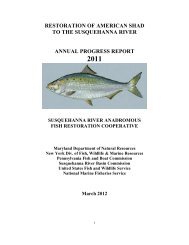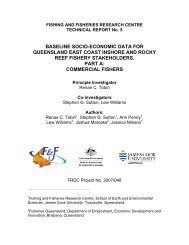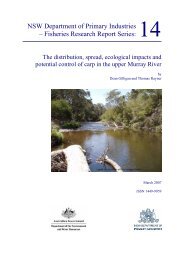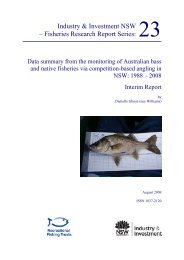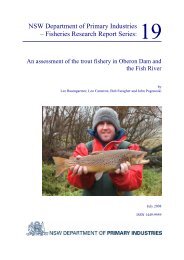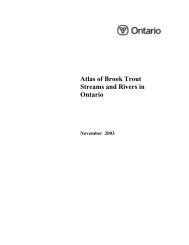Assessment of shark sighting rates by aerial ... - Fisheries Reports
Assessment of shark sighting rates by aerial ... - Fisheries Reports
Assessment of shark sighting rates by aerial ... - Fisheries Reports
Create successful ePaper yourself
Turn your PDF publications into a flip-book with our unique Google optimized e-Paper software.
NSW DPI 9<br />
The six flight transects lay 150 m apart, running in an east-west orientation to minimise sun glare to<br />
the sideways-looking observers. Two transects (E-F and G-H) lay within the deployment grid,<br />
while the other four lay outside (Fig. 2B). For each trial, the aircraft flew all six transects at 500 ft<br />
(~150 m), in the directions that ensured the observer was always facing towards the centre <strong>of</strong> the<br />
grid. When a <strong>shark</strong> analogue was sighted, the observer would notify the rest <strong>of</strong> the aircrew,<br />
signalling the pilot to mark a GPS waypoint, and the recorder to note both the GPS waypoint<br />
number and the observer’s estimate <strong>of</strong> the angle relative to the aircraft and distance to the analogue.<br />
Unless permitted, the aircraft would not deviate from its flightpath. Pilots would radio the number<br />
<strong>of</strong> analogues seen at the end <strong>of</strong> each transect, which was later verified against the datasheets.<br />
Datasheets were faxed <strong>by</strong> aircrew at the end <strong>of</strong> each day, with the latitude and longitude <strong>of</strong> each<br />
GPS waypoint included.<br />
On a number <strong>of</strong> occasions, analogues were deployed on the far northern or southern edge <strong>of</strong> the<br />
grid. In these cases, the individual analogues were outside the viewing area <strong>of</strong> observers on<br />
transects E-F or G-H, respectively (Fig. 2B). These analogues were therefore not included when<br />
calculating <strong>sighting</strong> <strong>rates</strong> <strong>of</strong> those transects.<br />
A<br />
C<br />
E<br />
G<br />
I<br />
K<br />
B<br />
X<br />
A<br />
X<br />
Jervis Bay,<br />
NSW<br />
X<br />
Figure 2. (A) Study location on the NSW coast showing the position <strong>of</strong> the survey grid in<br />
Jervis Bay. (B) Representation <strong>of</strong> the deployment grid (grey shading) showing the<br />
six 5 km-long transects flown <strong>by</strong> each aircraft per trial (not to scale). Letters<br />
represent transect coding given to aircrews. “X”s represent hypothetical analogue<br />
deployments. Observers faced southwards in transects A-B, C-D and E-F, and<br />
northwards in G-H, I-J and K-L. In this example, the circled analogue could not be<br />
seen on transect E-F and would not be included in that transect’s calculations. All<br />
other analogues could potentially be seen during each transect (up to six <strong>sighting</strong>s<br />
per trial).<br />
<strong>Assessment</strong> <strong>of</strong> <strong>shark</strong> <strong>sighting</strong> <strong>rates</strong> <strong>by</strong> <strong>aerial</strong> beach patrols Robbins et al.<br />
X<br />
5 km<br />
N<br />
X<br />
X<br />
B<br />
D<br />
F<br />
H<br />
J<br />
L




